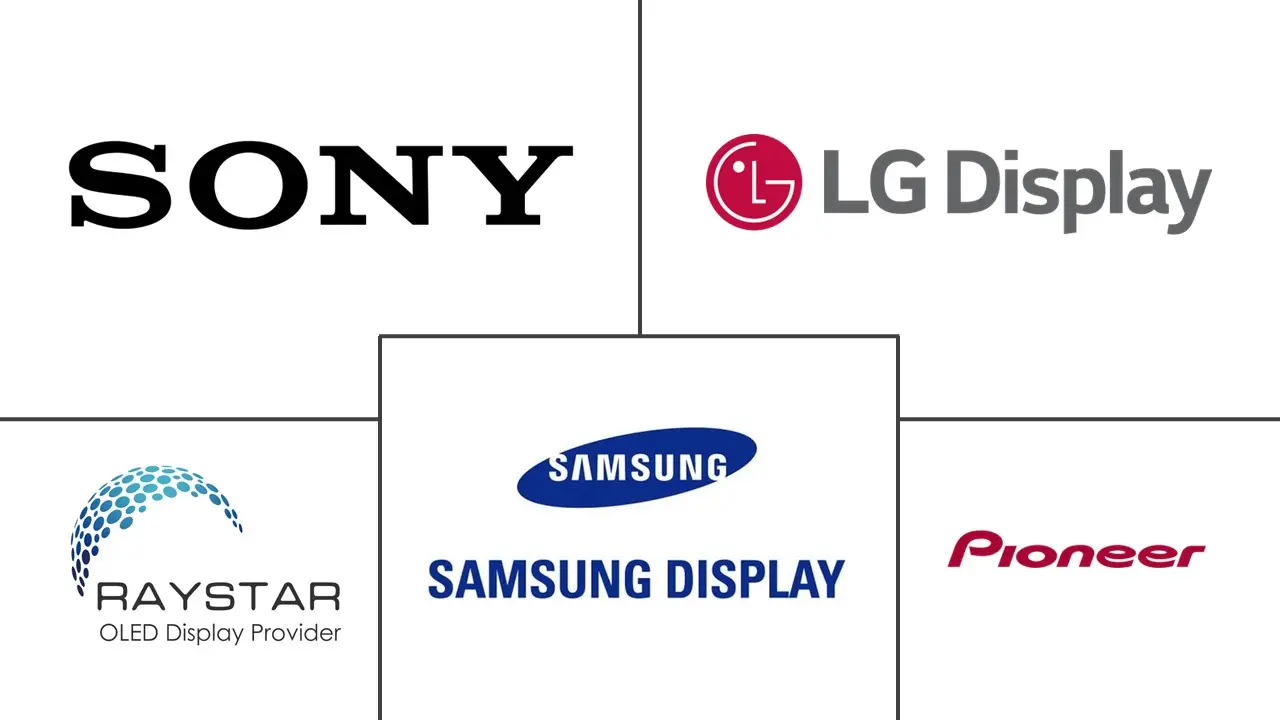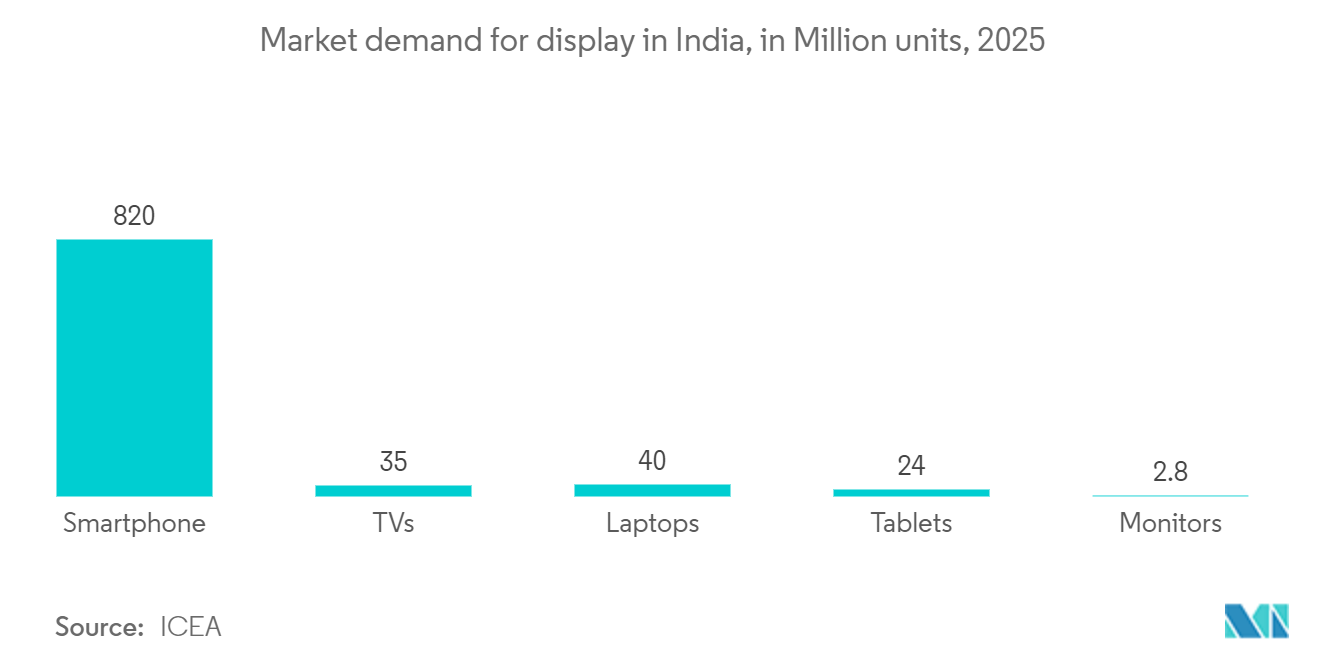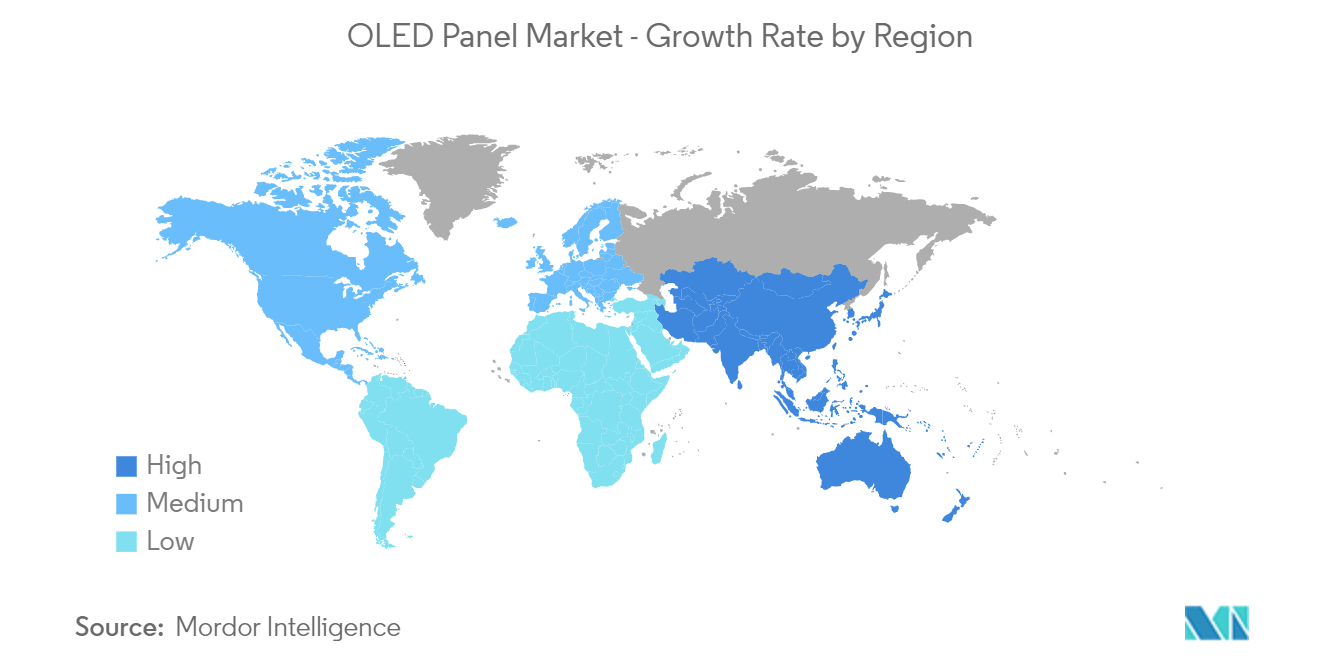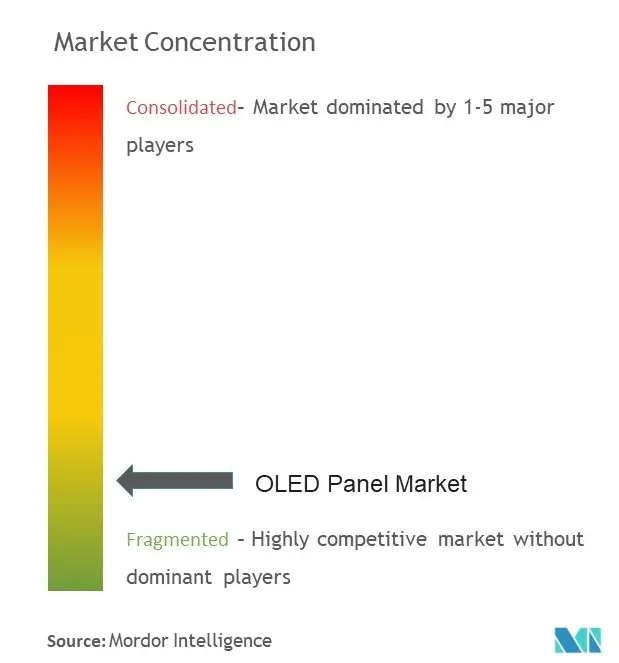OLED Panel Market Analysis
The OLED Panel Market size is estimated at USD 58.44 billion in 2025, and is expected to reach USD 108.58 billion by 2030, at a CAGR of 13.19% during the forecast period (2025-2030).
OLED is a significant display technology trend, with larger screen sizes, improved 8K (7680 x 4320 pixels) resolution, and relatively new form factors. For quite some time, companies like Samsung and LG have experimented with flexible OLED displays. Samsung, in particular, uses curved flexible OLED panels for all of its flagship devices now.
- OLEDs make it possible for emissive displays, where each pixel is independently controlled and generates its light (unlike LCDs, which get their light from a backlighting unit). OLED displays provide excellent visual quality, including vivid colors, quick motion, and, most significantly, a high contrast ratio. Most notably, "real" blacks (LCDs can't produce due to the illumination). Additionally, the straightforward OLED architecture makes it very simple to manufacture flexible and transparent panels.
- Due to multiple advantages with viewing angles and black levels, OLED Televisions are surging in demand in several regions. According to the ICDM, contrast modulation in qualifying a TV resolution is more critical than pure pixel count, and OLED TV displays cater to this demand.
- Based on market diffusion models, flexible OLEDs are anticipated to observe a high market penetration in the foreseen period. With the maturity of smartphones in many significant markets, such as China, smartphone manufacturers are developing new, foldable phone models that incorporate flexible OLEDs and further have a massive potential for growth over the next few years.
- Mass production enables companies to reach economies of scale, thereby benefiting the device manufacturers by reducing the overall price of the device. Only a few TV manufacturers currently use OLEDs, as the technology is considered too expensive for the mid-range market. Many fitness bands and simple smartwatch devices adopt PMOLED displays.
- For instance, Fitbit's Charge band uses a small monochrome (white) PMOLED display. The thickness, flexibility, and appearance of OLEDs show make it a promising technology for wearable applications over LCDs. Further, based on simple deterministic extrapolation, the demand for quantum dots-based OLED display panels is anticipated to surge exponentially in the forecast period.
OLED Panel Market Trends
AMOLED Display in Smartphone is Expected to Witness High Growth
- AMOLED is an OLED display technology used in tablets, smartwatches, game consoles, digital cameras, portable music players, and music-making equipment. The line pixel states are stored using a thin-film transistor (TFT) and a storage capacitor. AMOLED panels are far quicker than their passive matrix organic light-emitting diode (PMOLED) and can easily fit into displays of any size. In addition, they are more energy-efficient than previous display technologies, offer more vivid image quality and a broader viewing angle, and respond to motion more quickly.
- Globally, rapid urbanization, growing income levels, and expanding leisure and entertainment demand favorably impact consumer electronics sales. This is one of the most significant factors promoting the expansion of the AMOLED display sector. The operating expenses of manufacturing are anticipated to rise as a result of inflation in several places, including Sudan, Syria, Zimbabwe, etc. However, there are a number of benefits that AMOLED displays offer over other display technologies, including enhanced picture quality and a high-resolution display, both of which are propelling the market's expansion.
- Flexible AMOLED displays are often used in the creation of mobile phones, monitors, and wearable technology because they consume less energy and are more affordable than other displays. The operating expenses of manufacturing are anticipated to rise as a result of inflation in numerous places, including Sudan, Syria, India, and other countries.
- Technological advancements and the increasing use of OLED displays in smartphones provide lucrative growth opportunities. Furthermore, growing investments in OLED development by prominent electronics companies such as LG, Philips, and Sony will drive industry evolution during the growing period. For instance, in June 2022, LG Display collaborated with the Korean bakery Paris Baguette to install 38 transparent OLED displays for use as digital screens.
- Further, the OLED panel requires no additional backlighting, and it is emissive, due to which overshadows the flat panel displays traditionally used in smartphones. Additionally, owing to the superior properties, such as less thickness and bright output, mobile manufacturers have been increasingly incorporating AMOLED panels in their products, which is likely to drive market growth.
- Additionally, Samsung, one of the leaders in the OLED panels market, incorporates AMOLED and Super AMOLED display technologies in most of its smartphones.
- Continuous investment undertaken by numerous display factories to expand AMOLED production lines will boost the AMOLED penetration rate in the market. Moreover, the increasing demand for smartphone displays across the globe, owing to the increasing smartphone penetration rates, is expected to propel the demand for AMOLED panels in the market.
Asia Pacific Occupies the Largest Market Share
- Asia-Pacific is the biggest market for OLED panels as most key players, including LG and Samsung, have manufacturing facilities in the region. Additionally, several TV and signage display manufacturers and other vendors have headquarters in the APAC region.
- Due to the trade war between the United States and China, a large portion of the budget planned by the Chinese government is percolating into the display industry. In contrast, the semiconductor industry, one of the intensive investment promotion industries, foreshadows difficulties.
- Despite its small size, South Korea invests in academic R&D for OLED technology. The country is witnessing huge investments from electronics giants like LG and Samsung.
- China is on track to control 43% of the capacity for manufacturing OLED panels globally, putting it in striking reach of South Korea's rival. With hefty state subsidies, BOE Technology Group and TCL China Star Optoelectronics Technology (TCL CSOT) are two Chinese panel manufacturers that have increased output since around 2019.
- China is overtaking South Korea, whose capacity share, according to a projection made in October by the American market intelligence firm Display Supply Chain Consultants (DSCC), is supposed to reach 55% at the end of 2022. OLED panels, which employ organic light-emitting diodes, are developed and produced in many ways as liquid crystal display panels but need engineers with more in-depth technical knowledge.
- China is the global hub for manufacturing. It is one of the largest exporters of consumer goods and the fastest-growing consumer market in the world. The country boasts one of the world's largest television markets. For instance, LG plans to collaborate with retailers and TV makers in China to expand its OLED panel business. The sales of OLED display panels are expected to grow exponentially in the region.
OLED Panel Industry Overview
The OLED Panel Market is fragmented and competitive because of the presence of many players conducting business on a national and an international scale. Also, panel manufacturers are investing in alternative technologies for various players, which showcases an intense rivalry among the players. The major players in the market are Samsung Display Co. Ltd., LG Display Co. Ltd., and Sony Corporation.
In May 2023, Samsung Display is introducing Rollable Flex, which intends to revolutionize the mobility of tablet computers or laptops, and Sensor OLED display, which offers additional usefulness by incorporating blood pressure and fingerprint sensors in panels without attaching separate modules. With these and other OLED breakthroughs, Samsung is showcasing its desire to establish and dominate new market sectors.
In March 2023, to provide the best possible home entertainment experience, Sony Electronics Inc. introduced its BRAVIA XR TV lineup. The BRAVIA XR lineup has five new models: the X95L and X93L Mini LED, X90L Full Array LED, A95L QD-OLED, and A80L OLED. All models come with features that let customers enjoy immersive video, streaming applications, gaming, and other activities.
OLED Panel Market Leaders
-
Samsung Display Co. Ltd
-
LG Display Co., Ltd
-
Sony Corporation
-
Pioneer Corporation
-
Raystar Optronics Inc.
- *Disclaimer: Major Players sorted in no particular order
OLED Panel Market News
- January 2023: At CES 2023, LG Display, a pioneer in display technology, unveiled the third-generation OLED TV panel. The latest OLED TV panel from the manufacturer, based on "META Technology," offers the best possible image quality. The company's most recent OLED displays utilize META Technology to produce pictures that are 60% brighter than those produced by standard OLED productions and with viewing angles that are 30% broader.
- January 2023: Samsung Display announced it will produce a 77-inch Quantum Dot OLED panel. This company makes Quantum Dot OLED TVs for Samsung Electronics, Sony, and maybe other TV companies eager to adopt the technology.
- June 2022: LG Electronics introduced the CineBeam Projector and the UltraFine Display OLED in India. The company's two new products claim to provide an exceptional viewing experience with cutting-edge features and an interior-friendly design. LG's WebOS operating system powers the new LG CineBeam HU715Q projector. The 32EP950 UltraFine OLED Pro is a professional-grade monitor with actual 10-bit color, 99 percent DCI-P3 color gamut coverage, and 99 percent Adobe RGB color gamut coverage.
OLED Panel Industry Segmentation
The term "OLED" refers to an Organic Light-Emitting Diode, a technology that uses LEDs and emits light made of organic molecules instead of conventional means. The most incredible display panels in the world are said to be made with these organic LEDs. OLED displays are created by sandwiching several organic thin sheets between two conductors. An intense light is produced when an electrical current is supplied. A straightforward layout that has several advantages over other display technologies.
The OLED Panel Market is segmented by type (flexible, rigid, and transparent), by display address scheme (PMOLED displays, AMOLED displays), by size (small-sized OLED panels, medium-sized OLED panels, and large-sized OLED panels), by products (mobile and tablet, television, automotive, wearable), and by geography (North America [United States, Canada], Europe [United Kingdom, Germany, Italy, France, Rest of Europe], Asia Pacific [China, Japan, South Korea, India, Rest of Asia Pacific], Latin America [Brazil, Mexico, Rest of Latin America], Middle East and Africa). The market sizes and forecasts are provided in terms of value in USD for all the above segments.
| By Type | Flexible | ||
| Rigid | |||
| Transparent | |||
| By Display Address Scheme | PMOLED Display | ||
| AMOLED Display | |||
| By Size | Small-sized OLED Panel | ||
| Medium-sized OLED Panel | |||
| Large-sized OLED Panel | |||
| By Product | Mobile and Tablet | ||
| Television | |||
| Automotive | |||
| Wearable | |||
| Other Products (Lighting Products, Healthcare, and Home Appliances) | |||
| By Geography*** | North America | United States | |
| Canada | |||
| Europe | United Kingdom | ||
| Germany | |||
| Italy | |||
| France | |||
| Asia | China | ||
| India | |||
| Japan | |||
| South Korea | |||
| Australia and New Zealand | |||
| Latin America | Brazil | ||
| Mexico | |||
| Middle East and Africa | |||
OLED Panel Market Research FAQs
How big is the OLED Panel Market?
The OLED Panel Market size is expected to reach USD 58.44 billion in 2025 and grow at a CAGR of 13.19% to reach USD 108.58 billion by 2030.
What is the current OLED Panel Market size?
In 2025, the OLED Panel Market size is expected to reach USD 58.44 billion.
Who are the key players in OLED Panel Market?
Samsung Display Co. Ltd, LG Display Co., Ltd, Sony Corporation, Pioneer Corporation and Raystar Optronics Inc. are the major companies operating in the OLED Panel Market.
Which is the fastest growing region in OLED Panel Market?
Europe is estimated to grow at the highest CAGR over the forecast period (2025-2030).
Which region has the biggest share in OLED Panel Market?
In 2025, the Asia Pacific accounts for the largest market share in OLED Panel Market.
What years does this OLED Panel Market cover, and what was the market size in 2024?
In 2024, the OLED Panel Market size was estimated at USD 50.73 billion. The report covers the OLED Panel Market historical market size for years: 2019, 2020, 2021, 2022, 2023 and 2024. The report also forecasts the OLED Panel Market size for years: 2025, 2026, 2027, 2028, 2029 and 2030.
Our Best Selling Reports
OLED Panel Industry Report
Statistics for the 2025 OLED Panel market share, size and revenue growth rate, created by Mordor Intelligence™ Industry Reports. OLED Panel analysis includes a market forecast outlook for 2025 to 2030 and historical overview. Get a sample of this industry analysis as a free report PDF download.







